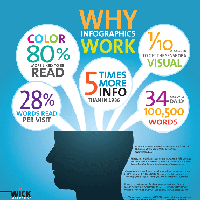How to Get Infographic Ideas to Spring Forth
Great blog posts rock. So do top-notch videos, eBooks, and a healthy list of other content types. What about infographics? They don't just rock; they roll. You see, when you knock one out of the park with other forms of content you're apt to earn links, generate a heap of social media shares, and perhaps inspire an interesting commentary stream. But something unique happens with a killer infographic …
It gets reposted. A lot. On all kinds of sites. And your brand goes with it, rolling across the social web like tumbleweed. Of course, it's gratifying, but it's also great for extending the reach of your brand and its message. 3 great places for infographic ideas I wrote this post to help you brainstorm ideas for effective infographics. Here are some smart starting points:
Great big list of infographic ideas –The infographic I created near the end of this post features 25 concepts and themes that might work for your next infographic. It's not going to give you your topic, but you're bound to find a style to shake ideas loose. Other infographics – It shouldn't surprise you to learn that many of the 25 ideas I visualized for you came from a deep dive into, yes, infographics. I went surfing on sites like Visual.ly and Pinterest where I knew I'd find them. I did some image searches. I recommend you do the same. Look at the infographics ranking high in your niche. Obviously, tuning into your market's blogs gives you writing ideas. The same goes for infographics. SlideShare – Some SlideShare content will be infographics, but SlideShare's sweet spot is slide presentations. And the millions of concepts you'll discover are bound to make creative sparks fly. Infographics were the inspiration for some of the decks. Now flip that equation. Dig up buried treasures If you've been creating content for a while, you may be sitting on a treasure trove of winning infographics ideas. Examine your most popular posts. Look at your page views and share numbers. Chances are some of your popular blog posts can be remade as infographics. List posts are particularly good candidates.
Mine your site. Does your site feature an FAQ? Perhaps you dedicate pages to detailing effective processes. Case studies could work. Have you published any research? How might you present that content in the ultra-friendly show-and-tell style of an infographic?
Open your outbox. The emails you and your colleagues send in response to customers' questions may be a perfect source for infographics ideas. Revisit presentations. There's a good chance the slide decks your sales team uses would make for strong infographics. If you haven't considered the content from your webinars, it's likely to work, too. Conduct brainstorm sessions I want to also encourage you to try some brainstorming sessions. Try techniques such as the following:
Word storm – Choose a meaningful word in your niche, then list words that come to mind. Various categories are likely to surface. Mind mapping – Start with one central idea, then attach related ideas to it. Allow the peripheral ideas to spawn new ones. Visual association – Start with a visual and do the word-storm and mind-mapping exercises. What if – Challenge your thinking with “what if” questions to invoke different points of view around a problem or creative challenge. Ask questions – Write the questions you have about your topic and answer them quickly – without overthinking. Your answers are going to inspire new questions. If you're going to brainstorm as a group, apply some ground rules. Give participants a heads-up. Lay out the objectives, in this case, to generate ideas for infographics. Ask each individual to get their ideas together in advance of the group session. Group brainstorms can inhibit some and the extroverts tend to take charge. When the group does come together, focus on quantity over quality. Encourage a free flow of ideas and discourage immediate evaluation of them. Judgment is a brainstorm spoiler. Make it fun and positive. Beer might be useful. Record every idea. Synthesize the ideas When you dig into my infographic below for style ideas, try some of the processes I suggest. You should have a healthy assortment of potential concepts to play with. Mix and match. Explore visual styles. Play around with titles. Collect ideas from infographics that earned your attention.
You'll want to strive for something that feels fresh and original, but I don't recommend you get too hung up on it. Useful trumps original. Even if you decide to develop an infographic around an idea similar to something you've seen before, I believe you can give your infographic a fresh spin and realize the enormous benefits that can come from publishing valuable content in the form of a new infographic.

